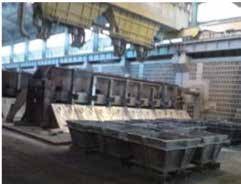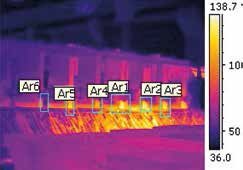Thermal imaging cameras optimise aluminium production
Wednesday, 11 December, 2013
Thermal imaging cameras are a welcome technology in the aluminium production industry. India’s JNARDDC institute is using thermal imagers to help aluminium production companies across the country save energy and find faults at a very early stage.
Aluminium is the second most abundant metallic element in the Earth’s crust and is also the world’s second most used metal. But aluminium production is an energy-intensive process, so saving energy at each step of the production process is the primary aim of process engineers and designers. Infrared thermography has played an important role in predictive maintenance of these processes.
Monitoring a production process can be performed best when processes are running, so online monitoring is particularly valuable. Slight temperature variations across a surface will indicate failing components, such as degrading electrical contacts. Thermography can also be used to inspect furnace ducts, bus isolator jumpers, casings, heating chambers or tanks.
Infrared thermography allows production managers to schedule their maintenance routines well before anything critical happens. This significantly reduces the production downtime. Predictive maintenance schedules help the industry to arrange tools and spares for repair in time, surveying such devices with thermal cameras for early detections of faults.
The Indian Jawaharlal Nehru Aluminium Research Development and Design Centre (JNARDDC) decided to purchase FLIR thermal cameras in 2002. The institute was supported by FLIR’s local distributor PCI, situated in Mumbai, who recommended JNARDDC use the FLIR P660 professional thermal imaging camera for predictive maintenance purposes.


In India, aluminium production companies usually carry out thermography inspections only when the need arises. Others will perform inspections on a yearly or half-yearly basis. The advent of thermal imaging in predictive maintenance programs has resulted in willingness to perform these maintenance routines more frequently, because inspection with thermal cameras no longer requires shutting down production.
The FLIR P660 thermal camera is now frequently used by the team of Anupam Agnihotri, head and scientist at JNARDDC, and consisting of SK Thokal (electrical engineer) and N Warhadpande (electronics engineer). Although the institute is enthusiastic about the use of FLIR’s technology, customers were a little hesitant at first.
“The operations people were a little hesitant at the initial period of inspection because they conceived infrared to be some kind of X-ray which would allow them to see inside the equipment,” said Agnihotri. “Others thought of infrared as being emitted by the camera and thought that it might harm their equipment.”
Fortunately, it was an easy task for FLIR Systems and PCI to explain the benefits and background of thermal imaging. After a short training program, JNARDDC customers were convinced and understood the importance of online condition monitoring with thermal imaging.
“Now operations managers demand to cover the problematic area more frequently than other areas,” said Agnihotri. “JNARDDC is now assisting with the design of predictive programs for a breakdown-free plant environment with the help of plant people and their management.”
The FLIR P660 camera is a high-performing infrared inspection system featuring 640 x 480 detector resolution and an ergonomic design. The easy-to-operate infrared camera delivers accurate temperature measurements at safe distances.
The P660 includes an integrated 3.2 MP camera to aid in reporting. Infrared and visual images taken with the product can be stored in standard JPEG formats. The camera includes matching field-of-view lenses, so IR and visual images are shown at similar long distances using the same field of view. It is suitable for efficient predictive maintenance programs.
Can we really 'electrify everything'?
Energy experts have debated the practicality of achieving full electrification on a global or...
Councils collectively save on energy
Thirteen regional New South Wales councils have pooled their resources to make the shift to...
From coal to clean: accelerating Asia's renewable energy transition
As Asia faces mounting climate challenges and rising energy demands, the push to shift from coal...









